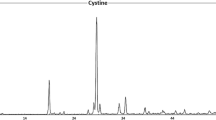Abstract
Many theories have been put forward to explain the mechanism of stone formation and growth. The aim of this study was to investigate the urinary, serum and stone levels of zinc, iron, magnesium, and copper in patients with calcium oxalate stones and to investigate urinary and serum element levels in healthy controls and to find a possible connection between the elements and calcium oxalate stone formation. A total of 104 patients with calcium oxalate stones ranging in age from 3 to 79 years (mean 44.0 ± 18.1) and 77 healthy controls ranging in age from 18 to 77 (mean 44.2 ± 17.9) were included in this study. The mean urinary iron and copper levels in stone patients were significantly higher than healthy controls (P = 0.000). The mean urinary zinc and magnesium levels in healthy controls were significantly higher than stone patients (P = 0.000). There was no significant difference in the serum levels of magnesium and copper in stone patients and healthy controls. Serum zinc and iron level were significantly high in healthy controls as compared to stone patients. Each stone had all 4 elements. Zn and Mg have inhibitory effect on calcium oxalate stone formation. Fe and Cu could be promotor of the calcium oxalate stone formation.
Similar content being viewed by others
References
Rangnekar GV, Gaur MS (1993) Serum and urinary zinc levels in urolithiasis. Br J Urol 71:527–529
Fleisch H (1978) Inhibitors and promoters of stone formation. Kidney Int 13:361
Joost J, Tessadri R (1987) Trace element investigations in kidney stone patients. Eur Urol 13:264–270
Thomas WE, Bird ED, Tomita A (1963) Some concepts concerning the genesis of urinary calculi. Invest Urol 90:521–526
Meyer JL, Angino EE (1977) The role of trace metals in calcium urolithiasis. Invest Urol 14:347–350
Trinchieri A, Mandressi A, Luongo P, Longo G, Pisani E (1991) The influence of diet on urinary risk factors for stones in healthy subjects and idiopathic renal calcium stone formers. Br J Urol 67:230–236
Komleh K, Hada P, Pendse AK, Singh PP (1990) Zinc, copper and manganase in serum, urine, and stones. Int Urol Nephrol 22:113–118
Ozgurtas T, Yakut G, Gulec M, Serdar M, Kutluay T (2004) Role of urinary zinc and copper on calcium oxalate stone formation. Urol Int 72:233–236
Kumar S, Gupta A, Shrivastava DK (1984) Role of zinc in nephrolithiasis. J Indian Med Assoc 82:235–237
Francois B, Cahen R, Pascal B (1986) Inhibitors of urinary stone formation in 40 recurrent stone formers. Br J Urol 58:479–483
Anke M, Schneider HJ (1973) Die bedeutung der spurenelemente in der pathogenese and Therapie der urolithiasis. III. Jenaer Harnsteinsymposium, pp 116–126
Elliot JS, Ribeiro ME (1973) The urinary excretion of trace metals in patients with calcium oxalate urinary stone. Invest Urol 10:253–255
Hofbauer J, Steffan I, Hobarth K, Vujicic G, Schwetz H, Reich G, Zechner O (1991) Trace elements and urinary stone formation: new aspects of the pathological mechanism of urinary stone formation. J Urol 145:93–96
Welshman SG, Mcgeown MG (1972) A quantitative investigation of the effects on the growth of calcium oxalate crystals on potential inhibitors. Br J Urol 44:677–680
Cohanim M, Yendt ER (1975) The effects of thiazides on serum and urinary zinc in patients with renal calculi. Johns Hopkins Med J 136:137–141
Kohri K, Garside J, Blacklock NJ (1988) The role of magnesium in calcium oxalate urolithiasis. Br J Urol 61:107–112
Li MK, Blacklock NJ, Garside J (1985) Effects of magnesium on calcium oxalate crystallization. J Urol 133:123–128
Borden TA, Lyon ES (1969) The effects of magnesium on pH on experimental calcium oxalate disease. Invest Urol 6:412–420
Fragalla FF, Gershoff SN (1963) Interrelations among magnesium, vitamin B6, sulfur or phosphorus in the formation of kidney stones in the rat. J Nutr 81:60–72
Rattan V, Thind SK, Jethi RK, Sidhu H, Nath R (1993) Oxalate metabolism in magnesium-deficient rats. Magnesium Res 6:127–133
Rushton HG, Spector M (1982) Effect of magnesium deficiency in intratubular calcium oxalate formation and crystalluria in hyperoxaluric rats. J Urol 127:598–603
Wu N, Thon WF, Krah H, Schlick R, Jonas U (1984) Effects of magnesium citrate and phytin on reducing urinary calcium excretion in rats. World J Urol 12:323–329
Esen T, Akinci M, Tellaloglu S, Kocak T (1991) Role of inhibitor deficiency in urolithiasis II: deficiency grade-adjusted and intermitent augmentation therapy for magnesium and citrate deficiency. Eur Urol 19:244–248
Johansson G, Backman U, Danielson BG, Fellstrom B, Ljunghall S, Wikstrom B (1980) Biochemical and clinical effects of prophylactic treatment of renal calcium stones with magnesium hydroxide. J Urol 124:770–774
Schmiedl A, Schwille PO (1996) Magnesium status in idiopathic calcium urolithiasis – an orientational study in younger males. Eur J Clin Chem Clin Biochem 34:393–400
Bird ED, Thomas WC (1963) Effect of various metals on mineralization in vitro. Proc Soc Exp Biol Med 112:640
Author information
Authors and Affiliations
Corresponding author
Rights and permissions
About this article
Cite this article
Atakan, I.H., Kaplan, M., Seren, G. et al. Serum, urinary and stone zinc, iron, magnesium and copper levels in idiopathic calcium oxalate stone patients. Int Urol Nephrol 39, 351–356 (2007). https://doi.org/10.1007/s11255-006-9050-4
Published:
Issue Date:
DOI: https://doi.org/10.1007/s11255-006-9050-4




